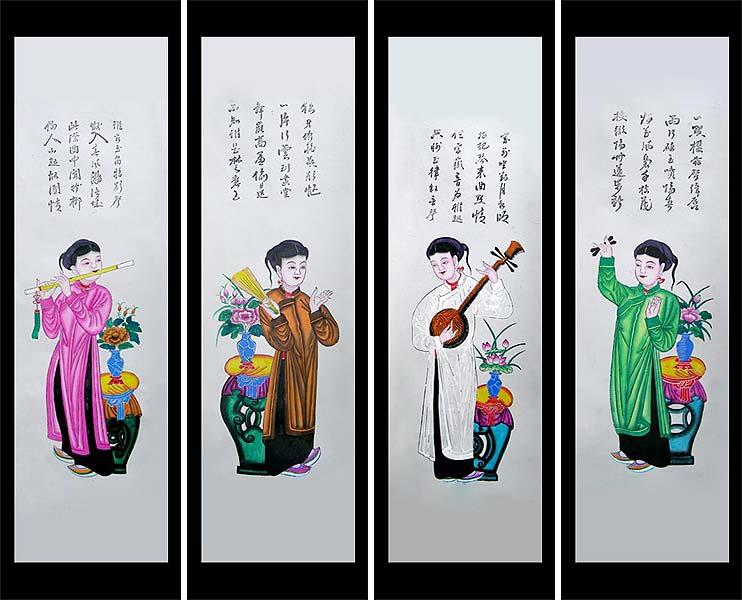Sáo on:
[Wikipedia]
[Google]
[Amazon]
The ''sáo'' (also called ''sáo trúc'' — pronounced , like "''shall-joog"'') is a family of
 The ''sáo'' contains the musical spirit of Vietnamese countryside and its four peaceful seasons. In Vietnam, the people played ''sáo'' when resting on the fields or before going to sleep at night. By the end of the 1970s, artists Đinh Thìn and Ngo Nam modernized the ''sáo'' by making this 6-finger-hole flute into 10-finger-hole flute, extending its register. Examples of the difference between the two variations of the flute can be heard in Đinh Thìn's "Tiếng gọi mùa xuân" and Mão Mèo's performance of "tình xưa nghĩa cũ".
The ''sáo'' contains the musical spirit of Vietnamese countryside and its four peaceful seasons. In Vietnam, the people played ''sáo'' when resting on the fields or before going to sleep at night. By the end of the 1970s, artists Đinh Thìn and Ngo Nam modernized the ''sáo'' by making this 6-finger-hole flute into 10-finger-hole flute, extending its register. Examples of the difference between the two variations of the flute can be heard in Đinh Thìn's "Tiếng gọi mùa xuân" and Mão Mèo's performance of "tình xưa nghĩa cũ".
flutes
The flute is a member of a family of musical instruments in the woodwind group. Like all woodwinds, flutes are aerophones, producing sound with a vibrating column of air. Flutes produce sound when the player's air flows across an opening. In th ...
found in Vietnam
Vietnam, officially the Socialist Republic of Vietnam (SRV), is a country at the eastern edge of mainland Southeast Asia, with an area of about and a population of over 100 million, making it the world's List of countries and depende ...
, considered a symbol of rural Vietnam. ''Sáo'' is the literal Vietnamese word for "flute". The most common variety is played with the flutist holding the ''sáo'' transversely to the right side with their mouth placed at the blowing hole. Other varieties include the ''Sáo Dọc'', a kind of recorder similar to the Thai Khlui, the ''Sáo Bầu'', and the ''Sáo Ôi'', a recorder played by the Muong people
The Mường (Muong language, Mường Bi dialect: ''mõl Mường''; ) are an ethnic group native to northern Vietnam. The Mường is the country's third largest of 53 minority groups, with an estimated population of 1.45 million (according ...
. The ''sáo'' is usually performed solo or in an ensemble among other instruments in orchestras of Vietnamese popular opera Chèo
Chèo (, Chữ Nôm: 嘲) is a form of generally satirical musical theatre, often encompassing dance, traditionally performed by Vietnamese peasants in northern Vietnam. It is usually performed outdoors by semi-amateur touring groups, stereo-typ ...
, Chầu văn
Hát chầu văn (, chữ Nôm: 喝朝文), or in secular form hát văn (喝文),Dale Alan Olsen, ''Popular music of Vietnam: the politics of remembering'', 2008. p 278. index "chầu văn, ..." several entries. is a traditional folk art of north ...
, and Nhã nhạc.
Construction and materials
Most frequently made from a single piece ofbamboo
Bamboos are a diverse group of mostly evergreen perennial plant, perennial flowering plants making up the subfamily (biology), subfamily Bambusoideae of the grass family Poaceae. Giant bamboos are the largest members of the grass family, in th ...
, the ''sáo'' measures between 40 and 55 centimeters in length and 1.5 to 2 centimeters in diameter, with six or ten finger holes and a tuning slide. Located inside the bamboo tube, near the oval blowing hole, is a soft wooden piece that adjust pitches when necessary. The first hole after the blowing hole is 12 centimeters away, while the other holes continue at a distance of 1 centimeter apart. At the other end of the flute, there is a non-covering hole called definite pitch hole, making it easier for the listener to discern pitch. The simple construction of the holes allow for very complex techniques in playing the instrument such as the use of breath with changes in the blowing angle for great or minute changes in sound quality, or partial-holding of finger holes to make delicate pitch changes. In the past, some flutes had a membrane similar to those on the Chinese Dizi, but these are not used anymore.
Cultural uses and renovations
See also
*Bamboo musical instruments
Bamboos natural hollow form makes it an obvious choice for many musical instruments. In South and South East Asia, traditional uses of bamboo the instrument include various types of woodwind instruments, such as flutes, and devices like xylopho ...
* Traditional Vietnamese musical instruments
Notes and references
Vietnamese musical instruments Side-blown flutes Bamboo flutes {{Flute-stub